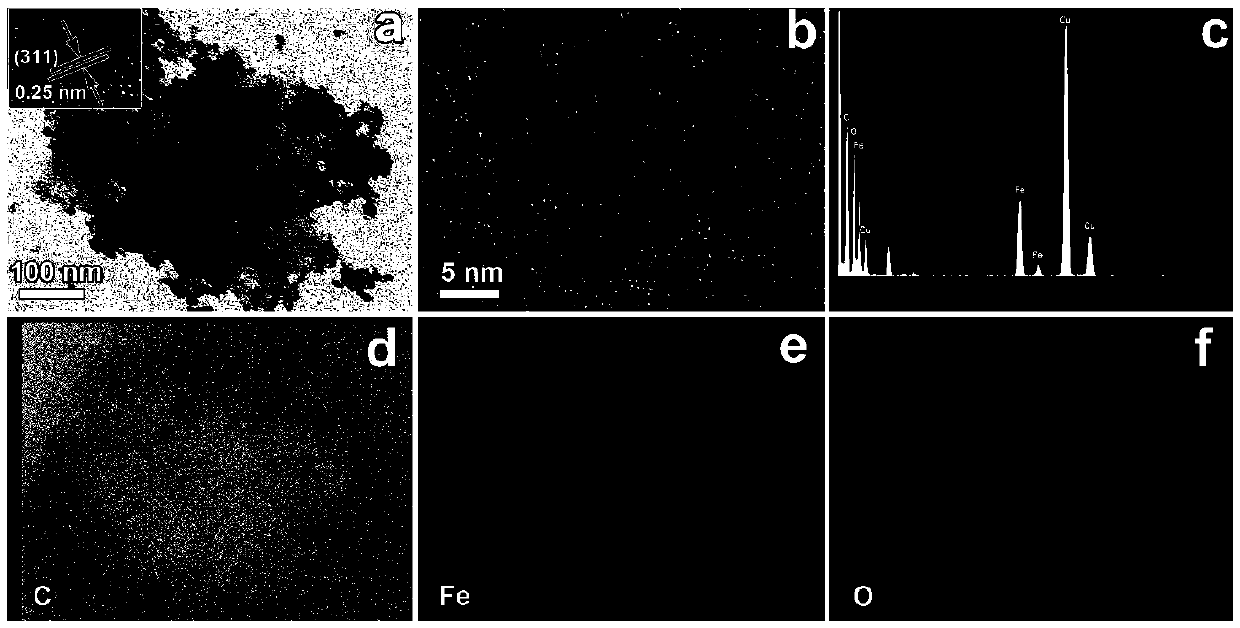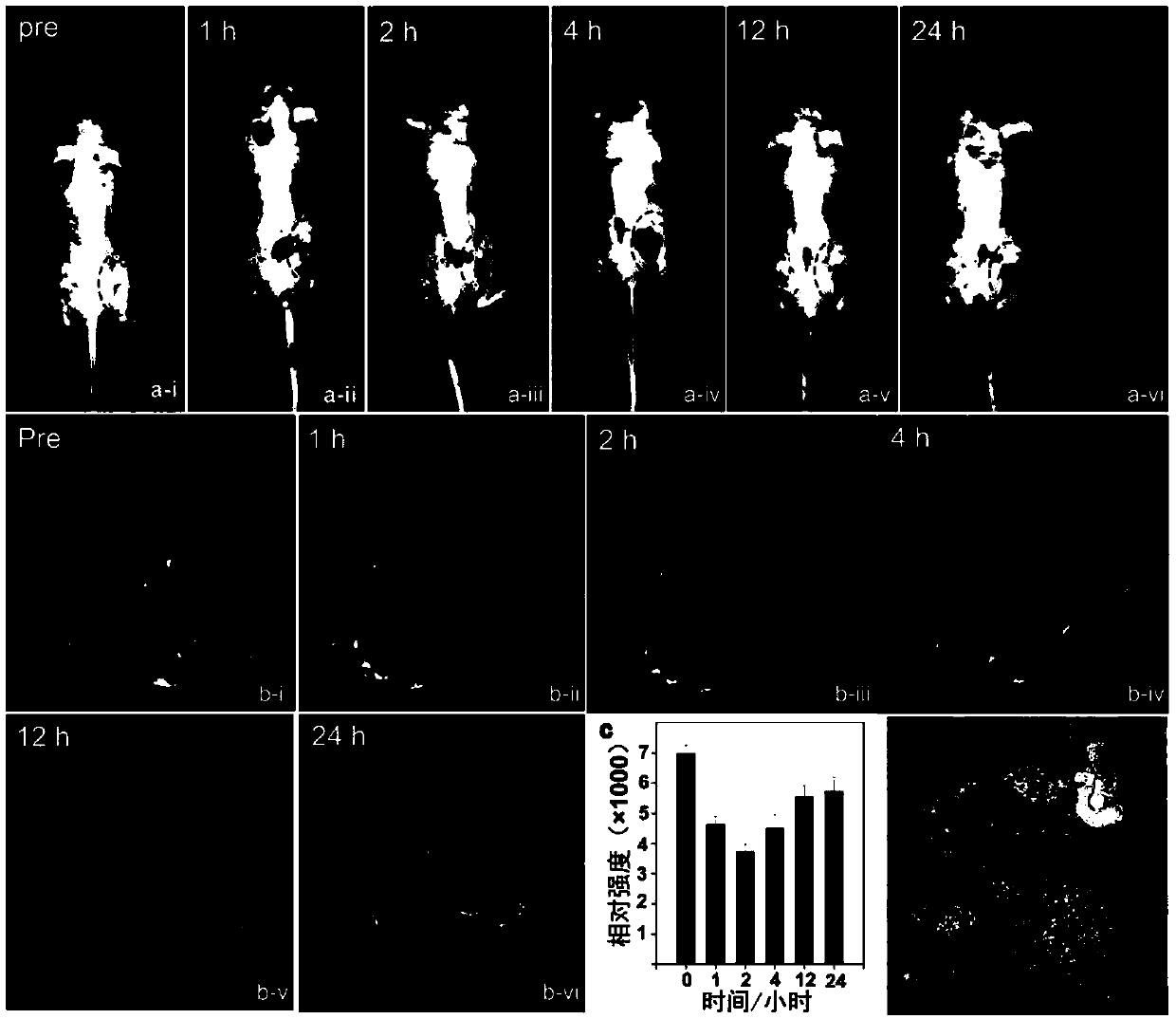A method for laser synthesis of magnetic graphene-peg-γ-Fe2O3 composites
A magnetic graphene, laser synthesis technology, applied in pharmaceutical formulations, preparations for in vivo experiments, MRI/MRI contrast agents, etc., can solve the problems of complex experimental steps, low yield, cytotoxicity, etc., and achieve simple The effect of the synthesis process
- Summary
- Abstract
- Description
- Claims
- Application Information
AI Technical Summary
Problems solved by technology
Method used
Image
Examples
Embodiment 1
[0019] This embodiment provides a method for synthesizing graphene-PEG-γ-Fe by nanosecond laser ablation in liquid phase 2 o 3 A compound method comprising the steps of:
[0020] (1) Using a block iron target with a purity of 99.9% as a raw material, polish the surface of the target with sandpaper, and ultrasonically clean it with dilute hydrochloric acid to remove its oxide layer; then ultrasonically clean the surface of the iron target twice with deionized water to remove Residual dilute hydrochloric acid, then dry the iron target for use;
[0021] (2) Put the dry iron target in a 50 ml beaker, add 20 ml of graphene-PEG solution with a concentration of 0.2 mg / mL, so that the liquid level above the iron target is 0.5-1.5 cm;
[0022] (3) Start the nanosecond laser, and use focused light with a wavelength of 1064 nanometers to ablate the iron target in step (2), wherein the laser energy, frequency, and action time are 180-250 mJ, 10-15 Hz, 30- 40 minutes; the target is move...
Embodiment 2
[0025] This embodiment provides a method for synthesizing graphene-PEG-γ-Fe by nanosecond laser ablation in liquid phase 2 o 3 A compound method comprising the steps of:
[0026] (1) Using a block iron target with a purity of 99.9% as a raw material, polish the surface of the target with sandpaper, and ultrasonically clean it with dilute hydrochloric acid to remove its oxide layer; then ultrasonically clean the surface of the iron target twice with deionized water to remove Residual dilute hydrochloric acid, then dry the iron target for use;
[0027] (2) Put the dry iron target in a 50 ml beaker, add 20 ml of graphene-PEG solution with a concentration of 0.5 mg / mL, so that the liquid level above the iron target is 0.5-1.5 cm;
[0028] (3) Start the nanosecond laser, and use focused light with a wavelength of 1064 nanometers to ablate the iron target in (2), where the laser energy, frequency, and action time are 180-250 mJ, 10-15 Hz, 30-40 Minutes; the target was moved every 2...
Embodiment 3
[0031] This embodiment provides a method for synthesizing graphene-PEG-γ-Fe by nanosecond laser ablation in liquid phase 2 o 3 A compound method comprising the steps of:
[0032] (1) Using a block iron target with a purity of 99.9% as a raw material, polish the surface of the target with sandpaper, and ultrasonically clean it with dilute hydrochloric acid to remove its oxide layer; then ultrasonically clean the surface of the iron target twice with deionized water to remove Residual dilute hydrochloric acid, then dry the iron target for use;
[0033] (2) Put the dry iron target in a 50 ml beaker, add 20 ml of graphene-PEG solution with a concentration of 0.8 mg / mL, so that the liquid level above the iron target is 0.5-1.5 cm;
[0034] (3) Start the nanosecond laser, and use focused light with a wavelength of 1064 nanometers to ablate the iron target in (2), where the laser energy, frequency, and action time are 180-250 mJ, 10-15 Hz, 30-40 Minutes; the target was moved every...
PUM
| Property | Measurement | Unit |
|---|---|---|
| concentration | aaaaa | aaaaa |
Abstract
Description
Claims
Application Information
 Login to View More
Login to View More - R&D
- Intellectual Property
- Life Sciences
- Materials
- Tech Scout
- Unparalleled Data Quality
- Higher Quality Content
- 60% Fewer Hallucinations
Browse by: Latest US Patents, China's latest patents, Technical Efficacy Thesaurus, Application Domain, Technology Topic, Popular Technical Reports.
© 2025 PatSnap. All rights reserved.Legal|Privacy policy|Modern Slavery Act Transparency Statement|Sitemap|About US| Contact US: help@patsnap.com



